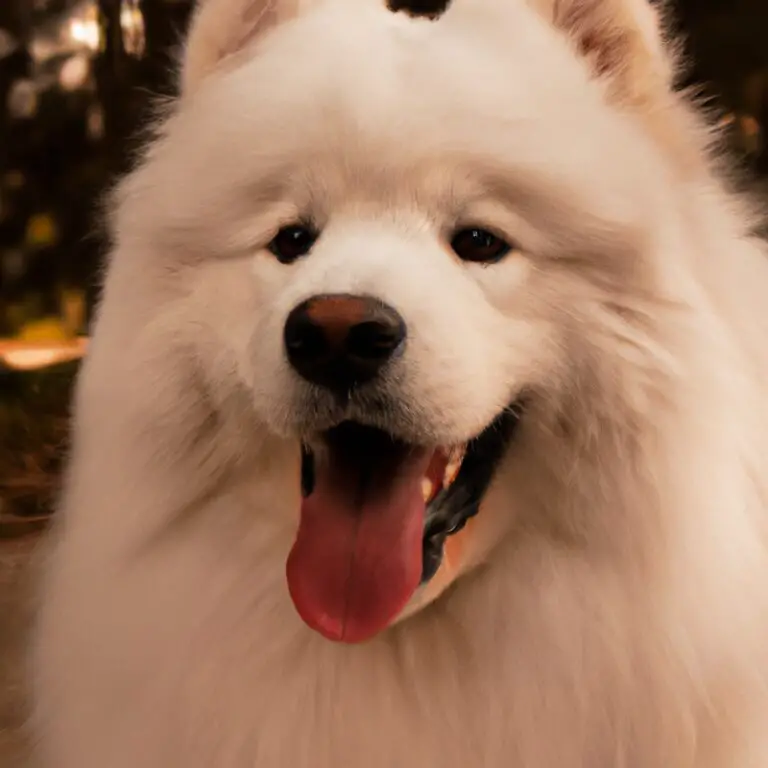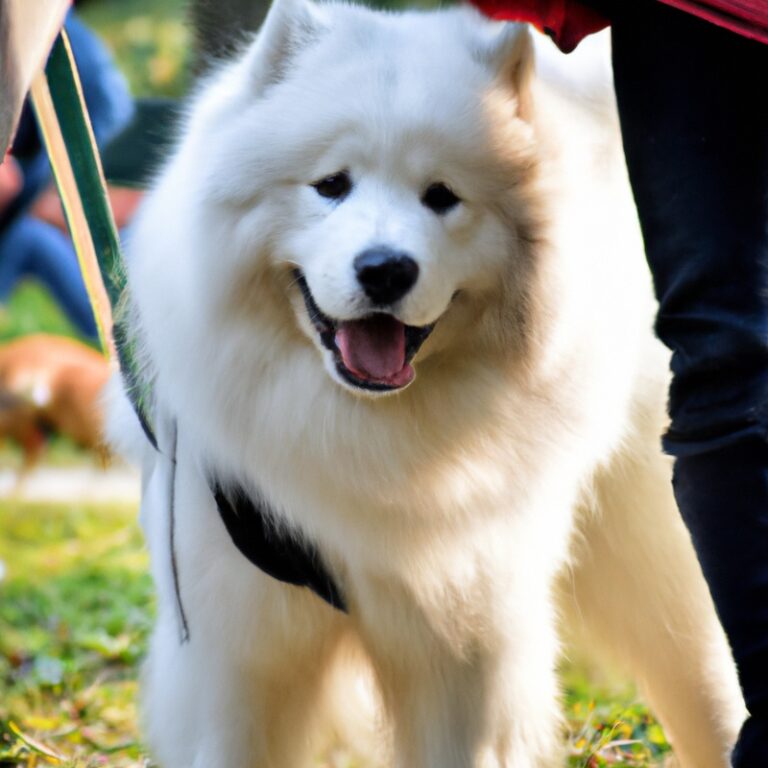Are Samoyeds Good Swimmers?
Key Takeaways:
- Samoyeds are generally good swimmers due to their innate physical traits.
- However, individual Samoyed dogs may vary in their swimming abilities and preferences.
- Proper training and gradual exposure to water can improve a Samoyed’s swimming skills.
- Supervision is important when Samoyeds swim, as they can tire easily in water.
Have you ever seen a Samoyed floating effortlessly in the water, their thick fluffy coat glistening in the sunlight? It’s a sight to behold.
But, do these adorable snowballs really possess the natural instincts to excel in the water?
As an expert in canine physiology and behavior, I can assure you – Samoyeds are indeed excellent swimmers. Their thick coat, webbed feet, and athletic build make them perfectly suited for aquatic adventures.
In this article, I will delve into the factors that make Samoyeds great swimmers, provide tips for introducing them to the water, discuss the benefits of swimming for Samoyeds, and address the potential challenges and precautions associated with their aquatic escapades.
Stay tuned to learn all about these snow-loving dogs’ prowess in the water!
| Pros | Cons |
| 1. Samoyeds have a thick double coat that provides excellent insulation and buoyancy in water. | 1. Samoyeds are not natural swimmers and may need to be taught how to swim properly. |
| 2. Their webbed feet help them paddle more efficiently in water. | 2. Samoyeds may be prone to hip dysplasia, which can affect their swimming ability. |
| 3. They have a friendly and sociable nature, making them more open to water activities. | 3. Samoyeds may be prone to eye conditions, such as cataracts, that may limit their ability to swim comfortably. |
| 4. Samoyeds are intelligent and trainable, which allows them to learn swimming techniques quickly. | 4. Some individual Samoyeds may simply not enjoy swimming and may be hesitant to enter the water. |
| 5. Swimming is a great form of exercise for Samoyeds, as it is low-impact and helps strengthen their muscles. | 5. It is important to supervise Samoyeds while swimming, especially in open water, to ensure their safety. |
Factors that make Samoyeds good swimmers
Thick coat and insulation properties
Samoyeds have a thick coat and excellent insulation properties, making them well-suited for swimming. Their dense double coat provides insulation and buoyancy in the water, allowing them to stay afloat easily.
The outer layer of their coat is composed of coarse guard hairs that repel water, while the soft undercoat keeps them warm and dry.
This unique combination of fur makes Samoyeds proficient swimmers, enabling them to navigate through water with ease.

Webbed feet and natural paddling ability
Samoyeds have webbed feet, which helps them swim efficiently. The webbing between their toes allows for better propulsion in the water, making them strong swimmers.
Additionally, Samoyeds have a natural paddling ability, thanks to their muscular build and well-developed shoulders.
This combination of webbed feet and natural paddling ability enables Samoyeds to navigate through water with ease. So if you’re thinking of taking your Samoyed for a swim, rest assured that their physical features make them well-suited for the activity.
Athletic build and strong limbs
Athletic build and strong limbs are key factors that make Samoyeds good swimmers.
Their muscular bodies and sturdy legs provide them with the necessary strength and agility to navigate through water with ease.
Additionally, their webbed feet help them paddle efficiently, making swimming a natural and enjoyable activity for this breed.
With their physical attributes, Samoyeds are well-equipped for swimming adventures.

Tips for introducing Samoyeds to swimming
Gradual introduction and positive reinforcement
When introducing your Samoyed to swimming, it’s important to take it slowly and use positive reinforcement.
Start by getting them comfortable around water, allowing them to explore at their own pace.
Use treats or toys as incentives to encourage them to approach the water and gradually move deeper as they become more confident.
Praise and reward them for their progress, making the experience enjoyable and positive.
With patient and positive guidance, your Samoyed can become a confident swimmer.
Choosing appropriate water environments
Choosing the right water environment is essential when introducing your Samoyed to swimming.
Here are some factors to consider:
- Quiet and calm waters: Look for locations with minimal waves and currents. A quiet environment will help your Samoyed feel more comfortable and reduce the risk of anxiety or panic.
- Temperature: Ensure the water is at a comfortable temperature for your dog. Samoyeds have a thick double coat, so cooler water may be preferable to prevent overheating.
- Shallow areas: Start in shallow water where your dog can easily touch the ground. This will build confidence and allow them to become familiar with the sensation of being in water.
- Safety measures: Always prioritize safety. Consider using a doggie life jacket for added flotation and security. Additionally, check for any potential hazards in the water, such as sharp objects or strong currents.
Remember to introduce swimming gradually and make it a positive experience for your Samoyed.
Patience, encouragement, and choosing the right water environment will help them develop their swimming skills with ease.
Using safety measures such as life jackets
Using safety measures such as life jackets is important when introducing Samoyeds to swimming.
Life jackets provide buoyancy and keep your Samoyed safe in the water.
They are specially designed to fit dog’s bodies and have handles for easy grabbing.
Additionally, make sure the life jacket is properly fastened and adjusted to ensure a secure fit.
With the right safety measures, you can have peace of mind while enjoying water activities with your Samoyed.

Benefits of swimming for Samoyeds
Physical exercise and muscle toning
Physical exercise and muscle toning are important aspects of a Samoyed’s overall health and well-being. Regular swimming sessions can provide an excellent form of physical exercise for your Samoyed, helping them to build muscle strength and maintain a healthy weight.
Swimming engages the entire body, providing a low-impact workout that is gentle on joints.
It also helps to increase cardiovascular fitness and improves coordination. By incorporating swimming into your Samoyed’s exercise routine, you can ensure they receive a well-rounded workout that promotes muscle toning and overall fitness.
Mental stimulation and stress relief
Swimming provides mental stimulation and stress relief for Samoyeds. It’s a refreshing and engaging activity that stimulates their minds, especially during training sessions.
The physical exertion of swimming also helps to relieve stress and release pent-up energy.
Additionally, the calming nature of water can have a soothing effect on Samoyeds, reducing anxiety and promoting relaxation. Swimming is a great way to keep your Samoyed mentally stimulated and stress-free.
Cool down on hot days
On hot days, it’s important to help your Samoyed cool down.
Here are a few ways to do that:
- Provide plenty of fresh water: Keep a constant supply of cool, clean water available so your Samoyed can stay hydrated.
- Provide shade: Create shaded areas in your yard where your dog can seek relief from the sun.
- Use cooling products: Use cooling mats, cooling vests, or wet bandanas to help lower your Samoyed’s body temperature.
- Limit exercise during the hottest parts of the day: Choose cooler times, such as early morning or late evening, for walks and playtime.
- Use a kiddie pool or sprinkler: Set up a kiddie pool or turn on the sprinkler for your Samoyed to splash around and cool off.
Remember to always monitor your Samoyed closely during hot weather to ensure their well-being and prevent overheating.
Potential challenges and precautions for swimming Samoyeds
Overexertion and fatigue
Overexertion and fatigue can be significant concerns for swimming Samoyeds. These dogs have a thick double coat that can weigh them down when wet, which can lead to exhaustion more quickly.
Additionally, their body structure is not specifically designed for swimming, making it more difficult for them to navigate in the water.
It’s important to monitor your Samoyed closely while swimming and provide breaks as needed to prevent overexertion and fatigue. Be attentive and watch out for signs of tiredness, such as heavy panting or slowed movements, and consider using a life jacket to assist with buoyancy.
Water hazards and safety concerns
Swimming can be enjoyable for Samoyeds, but it’s important to be aware of water hazards and safety concerns. Here are some things to keep in mind:
- Pools and deep bodies of water pose a drowning risk. Make sure your Samoyed is supervised at all times when near water.
- Be cautious of strong currents in rivers, lakes, or the ocean. These can be dangerous for dogs, even those who are strong swimmers.
- Avoid letting your Samoyed swim in water that may contain harmful substances, such as algae blooms or chemicals.
- Invest in a life jacket for your Samoyed. This can provide extra safety and buoyancy, especially if they are not strong swimmers or if you’re in an unfamiliar body of water.
- Rinse your dog with clean water after swimming to remove any chlorine, salt, or other chemicals that could irritate their skin or be ingested when they groom themselves.
Remember, every dog is different, so be sure to assess your Samoyed’s swimming abilities and comfort level before allowing them in the water.
Monitoring for signs of distress or discomfort
Monitoring for signs of distress or discomfort is essential when swimming with Samoyeds. Keep a close eye on their body language and behavior.
Watch for signs of fatigue, such as heavy panting or slowing down.
Be aware of any difficulty breathing or excessive coughing. Pay attention to changes in their buoyancy or if they start to struggle in the water.
Additionally, monitor for signs of anxiety or fear, such as trembling or trying to escape.
Stay vigilant and ready to intervene if necessary to ensure their safety and well-being in the water.
Frequently Asked Questions about Samoyeds and swimming
Can all Samoyeds swim?
Yes, all Samoyeds can swim! Samoyeds are natural swimmers and generally enjoy being in the water.
Their thick coat acts as insulation and helps keep them buoyant in the water.
However, like any dog breed, individual abilities may vary.
Some Samoyeds may be more confident or skilled swimmers than others.
It’s important to introduce your Samoyed to water gradually and provide them with a safe and supervised environment when swimming.
Keep in mind that not all Samoyeds may have a natural instinct to swim, so it’s best to assess your dog’s comfort level and swimming ability before allowing them in deep water.
What if my Samoyed dislikes water?
If your Samoyed dislikes water, it’s important to respect their preferences. Not all dogs enjoy swimming, and that’s perfectly normal.
Instead of forcing them into the water, you can try some alternative ways to keep them cool and entertained, such as:
- Providing a kiddie pool or shallow water play area in the backyard for them to play in and cool off.
- Introducing them to water gradually and in a positive way, using treats and praise to create positive associations.
- Offering mental and physical stimulation through other activities like fetch or puzzle toys.
- Considering other forms of exercise, such as hiking or playing in the snow, which Samoyeds tend to enjoy.
Remember, every dog is unique, and it’s okay if your Samoyed doesn’t enjoy swimming. The most important thing is to find activities that they do enjoy and keep them happy and healthy.
Can Samoyeds swim in cold water?
Samoyeds are excellent swimmers and can swim in cold water without any issues. Their thick double coat provides them with insulation, keeping them warm even in chilly temperatures.
The outer layer of their coat is also water-resistant, which helps to keep them dry while swimming.
However, it’s important to ensure that the water isn’t too cold for them and to monitor their exposure to it to prevent hypothermia. Additionally, it’s essential to supervise them while swimming to ensure their safety.
Final Verdict
Based on my expertise and knowledge, Samoyeds are indeed exceptional swimmers. Their thick coat and insulation properties, webbed feet, and natural paddling ability, combined with their athletic build and strong limbs, make them well-suited for swimming.
When introducing them to swimming, gradual introduction and positive reinforcement, along with choosing appropriate water environments and using safety measures, are crucial.
Swimming offers numerous benefits for Samoyeds, such as physical exercise, muscle toning, mental stimulation, and a way to cool down on hot days. However, it is important to be cautious of potential challenges and take precautions to ensure their safety, such as avoiding overexertion, monitoring for signs of distress, and being aware of water hazards.
Ultimately, swimming can be a rewarding and enjoyable activity for Samoyeds, enhancing their overall health and well-being.







